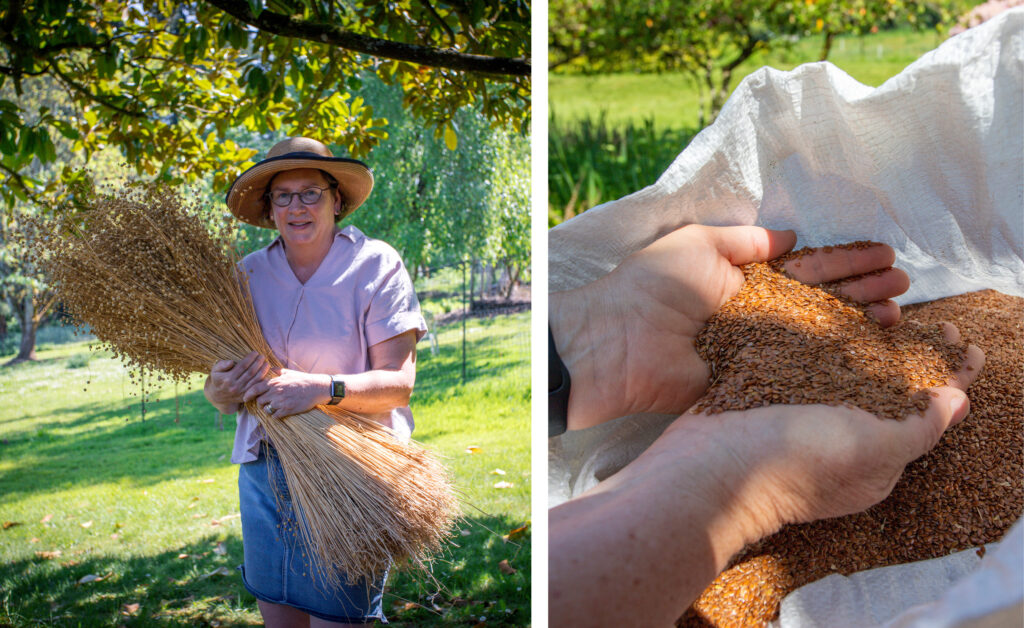by Jo Barnes | photos by Kathryn Alvarez Photography –
Ever heard of flax? Like most people, you might have a vague idea that it’s a plant with seeds that are good for digestion. Beyond that, the details get fuzzy. Flax is in fact the oldest textile fibre on the planet.
Well known to the Saanich Peninsula farming community and board member of the Growing Young Farmers Society, Carol Hyland recently started growing flax, a plant not only rooted in her field but also in her family roots.
“Flax and linen are part of my family folklore. It’s in my DNA,” shares Carol. “My dad grew up at Brontë’s Glen in Northern Ireland, the birthplace of Patrick Brontë, father of the famous literary sisters. There used to be endless fields of flax growing there.”
Carol and husband Trevor have been growing produce and raising livestock at their farm, Alderley Grange, since 2010. A few years ago, Carol wanted to grow a new type of produce and turned her thoughts toward flax. She knew of its current popularity in terms of health benefits, but she also knew from her family history its applications in the world of textiles. “My ancestors would make linen from the flax,” she shares. “They would roll out reams of fabric in the fields and let the sun bleach it white.”
Spurred on by these memories and a keen desire to try and grow flax herself, Carol began her journey. She wanted a flat area to grow the flax, and an opportunity arose when Sandown Centre for Regenerative Agriculture began a new program which matched her needs. “In 2020, Sandown offered me an incubator plot,” she says. “It was half an acre in size.”
She planted a variety of flax in test plots to learn how to grow and harvest the new plant. In 2021, she planted flax as a successful winter cover crop and pulled it in spring of 2021. Then a relationship with a Saanichton grain farmer brought a new opportunity.
“I learned that Field Five Farms also used flax as a cover crop, so they offered an acre area to plant my fibre flax seed,” comments Carol. “I had the seed, and they had the field and equipment. It was a great arrangement.”
She procured the flax seed from an American source which has proven successful. “I purchased my original seed from Fibrevolution in Oregon. It’s a genetic blend of seeds from Pacific Northwest flax called Linore. Originating from the Netherlands, Oregon State University saved and revived this variety,” she remarks, adding: “This flax is hardy.”
Carol is now learning how to process this remarkable plant. While flax can be used whole or ground or pressed for oil, the flax fibres can also be transformed into an array of products from textiles to twine to translucent paper.
The flax fibres, however, need to be freed from the outer core of the plant. This process is called “retting.” The flax is put into rainwater, and through the work of micro-organisms resulting from decay, the fibre separates from the main stem. Carol recalls her father talking about the retting ponds near his farm in Ireland where flax bundles were submerged under flat rocks, and the family tales of children accidentally falling into the rank water.
Now as well as growing the flax, she is learning to do the retting to utilize the fibres for making textile products. “I have always knit and made my own clothes. Now, I am learning how to spin flax,” she shares.
Carol’s desire to learn more has led to meeting other members of the local fibre community who work with flax and other fibers such as nettle or wool. This collaboration has introduced her to new environmental perspectives on clothing and fibre processing.
“There is a movement right now, establishing Fibresheds, which started in California,” she says. “It’s about getting away from microplastics in clothing and using only natural fibres. It’s about producing items that are long-lasting and repairable and not just tossed away.”
Keen to share her passion with others, Carol has made new connections as a member of the Vancouver Island Fibreshed and the North American Linen Association (NALA), organizations which promote sustainability and resilience in fibre flax agriculture and the textile industry. “I’m trying to help people grow flax by providing seed,” she says. “Growing and processing flax is yet another way to become sustainable.”
Beginning with a few flax seeds, Carol is now harvesting not only flax in the field, but enjoying valuable collaborations with the community. Farming has given her a new path forward while at the same time connecting her with her heritage. So, the next time you hear of flax, Carol’s hope is that your perception of this versatile plant will be a little less fuzzy.




